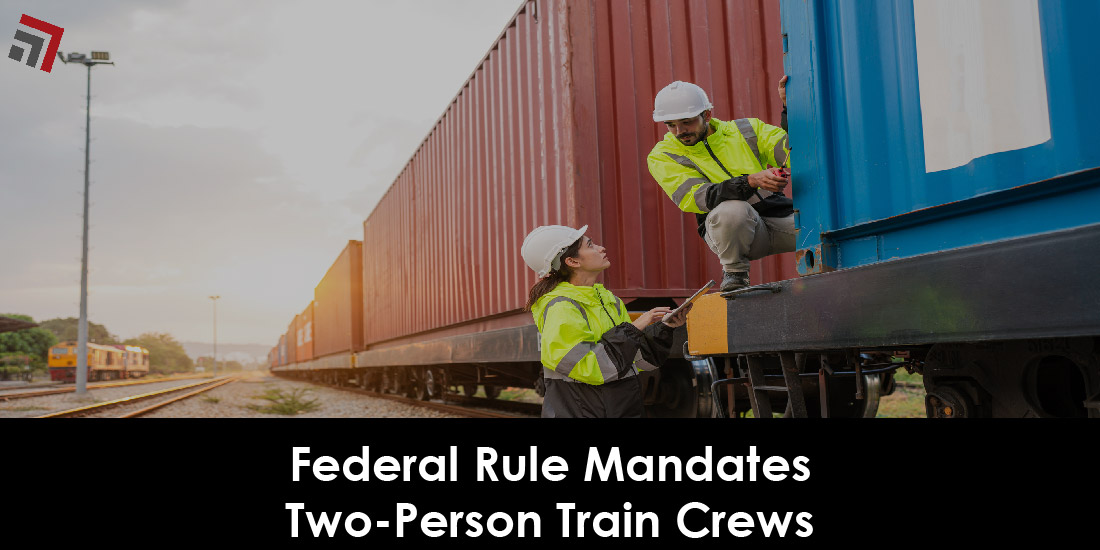Federal regulators overseeing the freight rail industry have declared a final ruling which will now require Class I railroads to maintain a minimum of two-person crews.
The Federal Railroad Administration (FRA), a federal agency under the U.S. Department of Transportation, finalized the rule on Apr. 2. The regulation takes effect 60 days following this publication date.
The duo crew requirement will apply on most railroad routes, however there is an exception for one-person operations on services that do not pose risk to employees, the public, or the environment. That said, if a railroad wishes to waive a particular route from the mandate, it would be required to submit a yearly report, detailing the operational safety, to the FRA.
Railroad safety remains in industry spotlight
Becoming a highly publicized issue following a disastrous derailment of a Norfolk Southern train in Ohio in early 2023, railroad safety, or lack thereof in the public eye, has since been the center of focus in an industry that already struggled with an uneasy service reputation. Among the notable issues that have been reaggravated: undermanned and overworked crews; a lack of visibility over hazmat hauling; and not-strict-enough fines or penalties for railroads that commit safety violations.
To the railroads’ credit, they have shown reasonable initiative towards addressing some of these concerns. Last year, several of them reached sick leave agreements with their employees’ union representatives. The move was a sign of good faith as the two sides collaborated on the new arrangements months after a contentious contract cycle which forced the unions to accept terms that they were not satisfied with.
However, other issues remain outstanding, particularly of labor ilk. The two-person crew requirement has been lauded as a major win for rail workers. Their unions have long advocated for this rule, citing that one-person crews are a risk to the jobs and safety of workers. While some labor agreements with Class I railroads already included two-person crews as a requirement, the federal mandate ensures it becomes the standard across major freight rail networks.
Additional crewmember will be a conductor
FRA’s final rule obliges that railroads must staff every train operation with a locomotive (train) engineer and an additional crewmember who will typically be a conductor. The added presence of a second person will help assist the engineer with operating the train, while also keeping them alert and responding to potential emergencies.
A common argument unions have made when advocating for two-person crews has been the rapid expansion of train size and length, with some stretching for miles.
“As trains—many carrying hazardous material—have grown longer, crews should not be getting smaller,” said Eddie Hall, the president of the Brotherhood of Locomotive Engineers and Trainmen union, in a news release.
In a press conference, Department of Transportation Secretary Pete Buttigieg noted that the U.S. should not stand complacent amid the current average of nearly three train derailments a day.
“When good safety rules have been put in place over the years, especially after high-profile incidents, we see derailments come down on mainline tracks,” the secretary stated.
Railroads denounce ruling, say regulators should not determine crew size
Over the years, railroads have not outright opposed two-person crews, but they have argued that lawmakers and regulators should not determine requirements on crew size. Instead, they assert the decision should stay behind industry doors—between them and unions in contract talks.
The American Association of Railroads (AAR), a trade group of railroads and stakeholders, criticized FRA’s ruling, claiming there is no evidence which correlates crew size to rail safety. AAR referenced the federal agency abandoning a similar proposal in 2019 after it could not identify enough evidence to warrant a mandate.
“FRA is doubling down on an unfounded and unnecessary regulation that has no proven connection to rail safety,” AAR President and CEO Ian Jefferies said in a news release. “Instead of prioritizing data-backed solutions to build a safer future for rail, FRA is looking to the past and upending the collective bargaining process.”
Two-person crew size has been a key issue in such talks for years, though the railroads retreated from the topic during their last contract cycle with unionized workers which ended in late 2022.
Final Thoughts
FRA’s final crew-size rule is primarily targeted at Class I railroads. The majority of smaller or short-haul railroads—Class II and Class III—are exempted from parts of the regulation. Certain passenger railroads and urban transit systems are also exempted. That said, these operators may still be susceptible to increased reporting measures at the discretion of FRA.
Contact one of our team members if you have any questions regarding this topic or any others in domestic logistics.
More blogs similar to this:



Recent Comments